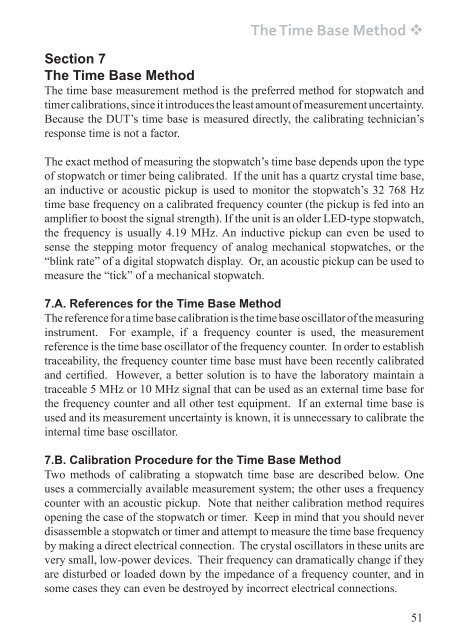Stopwatch and Timer Calibrations - National Institute of Standards ...
Stopwatch and Timer Calibrations - National Institute of Standards ...
Stopwatch and Timer Calibrations - National Institute of Standards ...
- No tags were found...
Create successful ePaper yourself
Turn your PDF publications into a flip-book with our unique Google optimized e-Paper software.
The Time Base Method <br />
Section 7<br />
The Time Base Method<br />
The time base measurement method is the preferred method for stopwatch <strong>and</strong><br />
timer calibrations, since it introduces the least amount <strong>of</strong> measurement uncertainty.<br />
Because the DUT’s time base is measured directly, the calibrating technician’s<br />
response time is not a factor.<br />
The exact method <strong>of</strong> measuring the stopwatch’s time base depends upon the type<br />
<strong>of</strong> stopwatch or timer being calibrated. If the unit has a quartz crystal time base,<br />
an inductive or acoustic pickup is used to monitor the stopwatch’s 32 768 Hz<br />
time base frequency on a calibrated frequency counter (the pickup is fed into an<br />
amplifier to boost the signal strength). If the unit is an older LED-type stopwatch,<br />
the frequency is usually 4.19 MHz. An inductive pickup can even be used to<br />
sense the stepping motor frequency <strong>of</strong> analog mechanical stopwatches, or the<br />
“blink rate” <strong>of</strong> a digital stopwatch display. Or, an acoustic pickup can be used to<br />
measure the “tick” <strong>of</strong> a mechanical stopwatch.<br />
7.A. References for the Time Base Method<br />
The reference for a time base calibration is the time base oscillator <strong>of</strong> the measuring<br />
instrument. For example, if a frequency counter is used, the measurement<br />
reference is the time base oscillator <strong>of</strong> the frequency counter. In order to establish<br />
traceability, the frequency counter time base must have been recently calibrated<br />
<strong>and</strong> certified. However, a better solution is to have the laboratory maintain a<br />
traceable 5 MHz or 10 MHz signal that can be used as an external time base for<br />
the frequency counter <strong>and</strong> all other test equipment. If an external time base is<br />
used <strong>and</strong> its measurement uncertainty is known, it is unnecessary to calibrate the<br />
internal time base oscillator.<br />
7.B. Calibration Procedure for the Time Base Method<br />
Two methods <strong>of</strong> calibrating a stopwatch time base are described below. One<br />
uses a commercially available measurement system; the other uses a frequency<br />
counter with an acoustic pickup. Note that neither calibration method requires<br />
opening the case <strong>of</strong> the stopwatch or timer. Keep in mind that you should never<br />
disassemble a stopwatch or timer <strong>and</strong> attempt to measure the time base frequency<br />
by making a direct electrical connection. The crystal oscillators in these units are<br />
very small, low-power devices. Their frequency can dramatically change if they<br />
are disturbed or loaded down by the impedance <strong>of</strong> a frequency counter, <strong>and</strong> in<br />
some cases they can even be destroyed by incorrect electrical connections.<br />
51
















